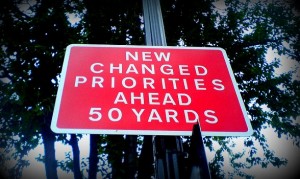
In the hilarious 1991 movie City Slickers, the Jack Palance character, Curly, gives a secret to Mitch (Billy Crystal). Holding up his index finger, Curly explains that you need to figure out your one thing and stick to it. Of course the secret is both to have “one thing” and also know how to determine what it should be.
We can take this wisdom and boil it down to a single principle.
The MIT Principle
No, this has nothing to do with the Sloan School of Management.
Therese Macan, a professor at the University of Missouri-St. Louis, conducted groundbreaking research into time management, productivity, and stress, discovering that the two most important keys are priorities and mechanics (i.e., the mechanics of implementing time management techniques and tactics).
Put simply, the most important things are to know what to focus on and how you are going to get it done. I call this always knowing your MIT: the most important task.
The key to your productivity all comes down to understanding what is most important to you—and what activity will provide the greatest leverage to getting there—right now.
Additionally, research that we’ve conducted at the Kruse Group in 2015 on over 4,000 working professionals indicates that sticking to a daily MIT correlates to higher levels of happiness and energy. It’s not just about productivity. When you know what you should be working on, you are happier. When you know what your focus should be, it energizes you.
How to Apply It
Briana Scurry, who won two gold medals as the starting goalkeeper for the United States women’s soccer team in 1996 and 2004, had this to say:
“About six months before an Olympics, I would relate all the decisions I made to the ultimate vision of winning gold. The simple question I would ask several times a day was, ‘Will this activity help me perform better and therefore help us win gold?’”
Randy Gage is author of nine books including the New York Times bestseller, Risky Is the New Safe. For Gage, success is measured in identifying his MIT and sticking to it:
“I always start with the most important thing on my priority list. If you didn’t spend your week working on the most important thing, it was a week wasted.”
Most people who set goals focus on health, wealth, and relationships. Others set goals for the “5 F’s”: Faith, Fitness, Family, Friends, Finance. Based on your goals, your MIT will be different from mine, and next month’s (or year’s) MIT will most likely be different than today’s.
It’s crucial is that you take the time to determine your big goals. Then, correctly identify what’s going to help you the most—right now—to achieve that. Here are some questions to help you to get at your big goal and MIT:
- What will you be evaluated on during your annual performance review?
- What does your boss care most about?
- How is your bonus determined?
- What would be the thing that would get you promoted if you could accomplish it?
When you know what your one thing is, you should try to schedule time for it as early in your day as possible, before other workplace emergencies pop up and derail your intentions.
When you determine your MIT, you’ll find that all those seemingly interesting opportunities are actually major distractions. You’ll also discover that by staying focused, you’ll reach your destination right on schedule.
—
Kevin Kruse is a keynote speaker and the author of the bestselling book 15 Secrets Successful People Know About Time Management.
Photo: Flickr/richardsummers
Originally published on Forbes.





